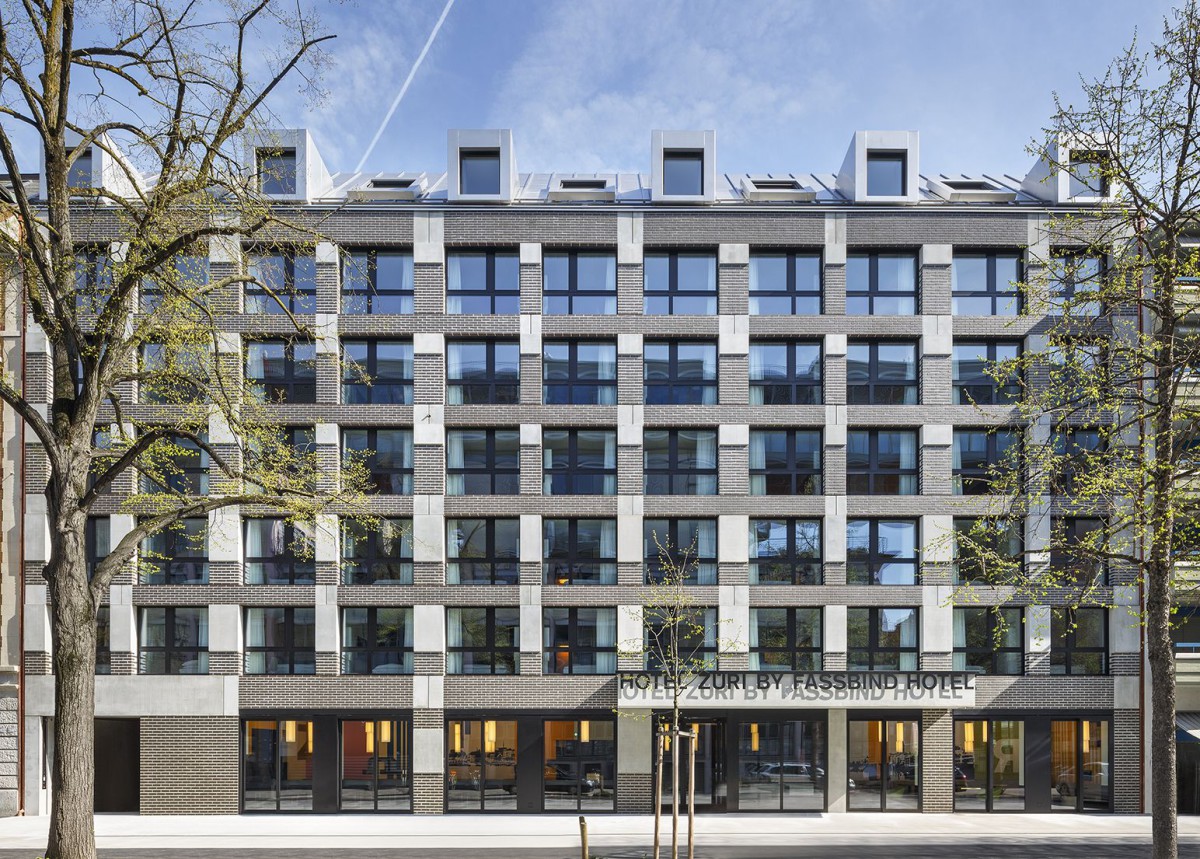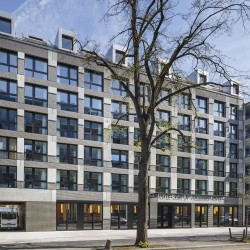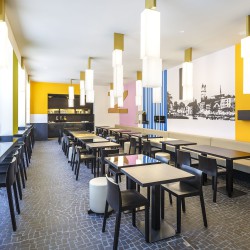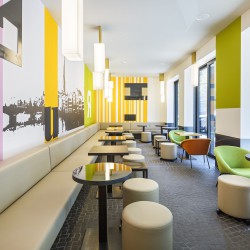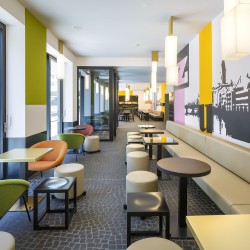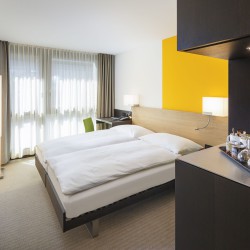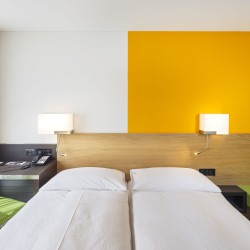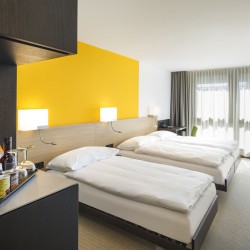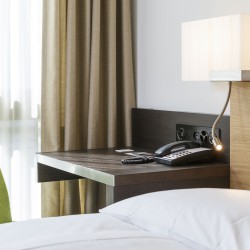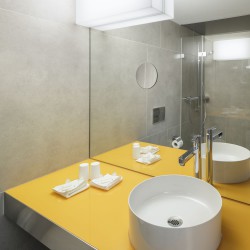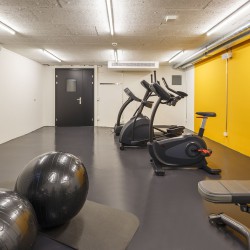Annette Gigon / Mike Guyer Architekten . + by Fassbind
In the former industrial district of Zürich-West, opposite the old Steinfels factory site and integrated in a late 19th century block edge development, the Hotel Senator from the 1980s has been converted into the new Hotel Züri by Fassbind.
_
It was possible to retain the building volume and the basic structure with floor slabs and partition walls of concrete almost unaltered. However the roof and the facades were rebuilt. Throughout the interior of the building, including the bathrooms, the fittings and furnishings were replaced.
The facade to the existing building structure has been newly clad with prefabricated elements which form generously sized window openings. The full-height timber and metal windows have frames of solid dark oak. Clinker bricks – one of the characteristics of the former industrial district – are used in the hotel facade but not as facing bricks, like in 19th century facades or as infill in frame structures, like with industrial buildings, here they take the form of “intarsia” that are cast in self-supporting, slightly projecting concrete elements (differently sized concrete “heads” terminate the vertical elements at the top and the horizontal elements at the sides. Some of the piers and lintels are entirely of concrete – as is the weighty protective canopy to the entrance area. In the passageway leading to the courtyard the way in which the clinker bricks were fixed with the help of matrices in the formwork for the concrete becomes understandable – namely where the matrices were cast without inserting any bricks). On the street front dark brown bricks were used, in the courtyard the bricks are beige.
To provide light for the new roof-top rooms areas of the chrome steel batten seam roof were opened up to make dormers and roof windows, which are themselves clad with chrome steel. Two dormers placed by side by side accentuate the corners of the courtyard wing – and in the interior enhance the tent-like corner rooms with a generously dimensioned “daylight lantern”.
The theme of contrasting pairs such as light and dark, above and below, lying and standing, restrained material colours and strong spectral colours is also found in the interior.
The built-in furniture in the hotel bedrooms is made of oak, both light and dark. Large mirrors guide one into the space and expand it – just like the windows that open the rooms towards the city. A bench upholstered in textile provides somewhere to put your suitcase or a place to sit. Letters woven into the grey- Colour is used to paint beige carpeting form good day / good night wishes, in English, French, Italian and German. Parts of the wall are painted in colour, which modifies the light in the rooms – the daylight and, above all, the artificial lighting, which uses LED wall and floor lamps made especially for these rooms.
Large lamps and areas of colour are also used to accentuate the hotel corridors and “shorten” them visually – above the level of trolley suitcases. Below this level robust metallic and cement-based panelling was used. Carpeting, also with lettering, dampens the sound of footsteps.
Together with the lounge and the breakfast area the lobby at ground floor level expands to form a spatial continuum that has large “display windows” facing Heinrichstrasse and the city. Here the flooring consists of cast clinker brick fragments of the same kind as used in the facade. Guests are welcomed by a reception area of oak and black sheet metal, bench seats that extend along the walls, and specially made tables, chairs and pendant lamps.
On Heinrichstrasse a generous forecourt in cast concrete invites guests to take their breakfast outdoors under the semi-shade of the trees. In the courtyard the patchwork of existing paving materials is augmented by coarse gravel, and large tree planters made of steel rebars give newly planted deciduous trees a chance to take root.
_
Project: Hotel Züri by Fassbind
Commission: Juli 2012
Planning/ Construction: 2012–2017
Client: Hotels by Fassbind
Architecture/ General Planning: Annette Gigon / Mike Guyer Architekten, Zurich
Collaborators:
Development and realisation:
Martin Feichtner (project manager), Cornelia Schmidt (deputy project manager), Eva Rosenova, Matthias Clivio, Christian Gammeter, Nicolas Hunkeler, Maxim Moskalenko, Luisa Wittgen
Interns: Sebastian Piel, Marine Cobo, Mirco Wieneke, Agnieszka Gronek
Preliminary design study to building permit application:
Pieter Rabijns (project manager up to permit application), Markus Seiler (project manager up to preliminary design study),
Franziska Bächer (project manager),
Martin Schwarz, Meret Morgenthaler, Marina Pedrazzini (Intern)
Construction Management: Ghisleni Partner AG, Rapperswil (sub-planner)
Gross Floor Area (SIA 416): 6‘280 m2
Usable Floor Area (SIA 416): 3‘310 m2
Plot: 1‘263 m2
Landscape Architecture: Rainer Zulauf, Studio Vulkan Landschaftsarchitektur, Zurich
Structural Engineer: Henauer Gugler AG, Zurich
Electrical Engineer: pbp ag engineering, Zurich Building Services Engineer: Gruenberg + Partner AG, Zurich
Building Physics Engineer/ Acoustics:
Gartenmann Engineering AG, Zurich
Fire Engineer: Basler & Hofmann AG, Zurich

